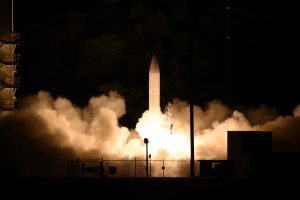The U.S. Navy says its submarines could begin to deploy hypersonic weapons as early as 2025, several years earlier than previous estimates of 2028.
The U.S. military is working on a common hypersonic weapon that will be fielded by the army, navy, air force, and potentially the marines as well. The weapon is a boost-glide design that is lifted to a high altitude by a booster rocket and then uses gravity and kinetic energy to glide at more than five times the speed of sound over thousands of miles to its target. Initially, the navy’s version will be launched from submarines, but may eventually be deployed on ships as well. Those initial submarine deployments were expected to begin sometime in 2028.
But the head of the navy’s strategic systems program, Vice Admiral Johnny Wolfe, told a forum this week that the navy’s hypersonic weapon will be deployed in some limited capacity on its guided missile submarines by 2025. The navy has four of these subs that carry large numbers of Tomahawk cruise missiles that were converted from its four oldest Ohio-class ballistic missile subs that used to carry nuclear weapons.
The plan appears to provide the United States with an interim sea-based hypersonic weapon until the navy’s newer Virginia-class attack subs are ready for them. New variants of the Virginia subs have longer hulls outfitted with extra, larger missile launch tubes that are big enough to accommodate the hypersonic weapon’s huge booster rocket.
The four converted Ohio-class missile subs are nearing 40 years of service and current navy plans call for retiring them starting in 2026, with the last leaving service sometime in 2028, the same year that the Virginia-class subs will be ready to begin deploying hypersonic weapons.
In addition to the push for an undersea hypersonic weapon capability that can strike theoretically strike an adversary nearly anywhere in under an hour, the navy is also planning to outfit its submarines with more anti-ship weapons. These include an anti-ship version of the Tomahawk cruise missile with a range of nearly 1000 miles that is expected to be ready in 2023, and the Harpoon missile with a range of about 70 miles.
Together this expanded arsenal will make the Virginia-class a potent answer to Chinese military capabilities that concern the United States: long-range anti-ship ballistic missiles like the two that China fired into the South China Sea this summer, along with the ground-based sensors that support their ability to target enemy fleets. The PLA Navy, which the DoD reported this summer already has the world’s most numerous fleet, is still growing and becoming more advanced and capable.
Despite the accelerating hypersonic arms race between the United States, China, and Russia, some analysts worry that their speed and the ability to strike practically any target could make crises even more dangerous and make escalation more likely. During a worsening international crisis, if China or Russia became worried that the United States might use its hypersonic arsenal to target their nuclear deterrents or national leadership, they might try to use their weapons first.
This may be a particular danger with ground-based hypersonic weapons, which China might feel pressured to strike early in a crisis before the United States used them. This creates a danger for crisis management between China and the United States, and also for any partner or ally in the region that might agree to host U.S. ground-based hypersonic weapons in the future.
Submarine-based hypersonic missiles may present their own challenges to crisis management, but their stealth reduces the threat or incentive of China striking them preemptively, as well as the risk that a partner country becomes an inadvertent target for China during a crisis.

































